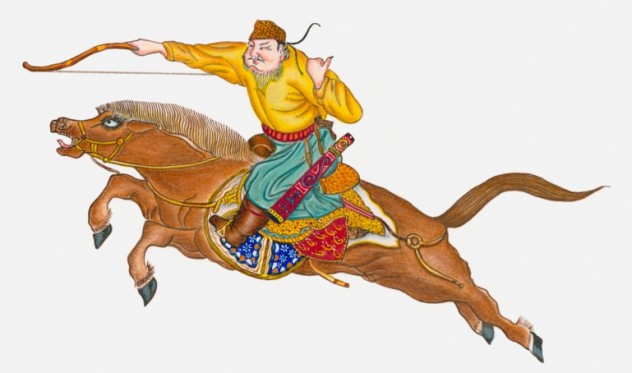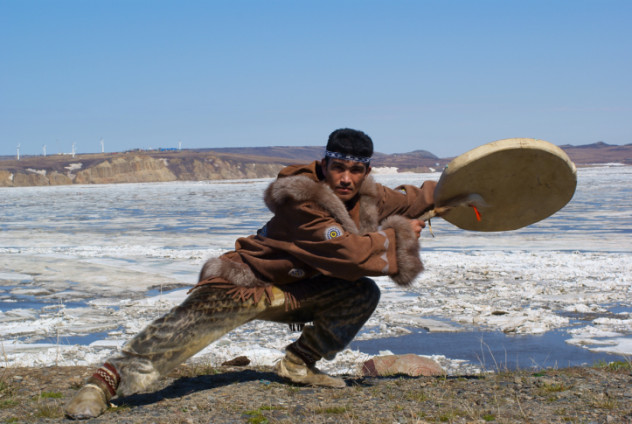 Weird Stuff
Weird Stuff  Weird Stuff
Weird Stuff  Animals
Animals 10 Inspiring Tales of Horses Being Human
 Mysteries
Mysteries Top 10 Haunting Facts About the Ghost Ship MV Alta
 History
History 10 Surprising Stories About the Texas Rangers
 Humans
Humans 10 Philosophers Who Were Driven Mad by Their Own Theories
 Miscellaneous
Miscellaneous 10 Video-Game-Worthy Weapons and Armors from History
 Weird Stuff
Weird Stuff 10 Psychics Who Accurately Predicted Wartime Events
 The Arts
The Arts 10 Pieces of Art Inspired by a Broken Heart
 Health
Health 10 Science Fiction-Sounding New Medical Treatments
 History
History 10 Surprising Facts About the Father of Submarine Warfare
 Weird Stuff
Weird Stuff 10 Times Real Laws Were Based on Bizarre Hypotheticals
 Animals
Animals 10 Inspiring Tales of Horses Being Human
 Mysteries
Mysteries Top 10 Haunting Facts About the Ghost Ship MV Alta
Who's Behind Listverse?

Jamie Frater
Head Editor
Jamie founded Listverse due to an insatiable desire to share fascinating, obscure, and bizarre facts. He has been a guest speaker on numerous national radio and television stations and is a five time published author.
More About Us History
History 10 Surprising Stories About the Texas Rangers
 Humans
Humans 10 Philosophers Who Were Driven Mad by Their Own Theories
 Miscellaneous
Miscellaneous 10 Video-Game-Worthy Weapons and Armors from History
 Weird Stuff
Weird Stuff 10 Psychics Who Accurately Predicted Wartime Events
 The Arts
The Arts 10 Pieces of Art Inspired by a Broken Heart
 Health
Health 10 Science Fiction-Sounding New Medical Treatments
 History
History 10 Surprising Facts About the Father of Submarine Warfare
10 Weird Things We’ve Learned About Ourselves From Genetics
In high school biology class, we learn about recessive and dominant genes—and more than we ever cared to know about pea plants and moths. But those lessons only scratch the surface of what can be revealed about the body through the study of genetics. Recent research into the genetics of mankind has revealed some new ideas about ourselves and our history that should make us look at ourselves in a new light.
10 The Genghis Khan Factor

A great number of people in the world today can trace their lineage right back to Genghis Khan, according to a widely accepted theory. A prolific conqueror whose armies swept across Asia, the emperor was also reported to be a prolific conqueror of another sort.
There’s a small problem, though. When a Florida accountant recently got the results of a DNA test that said he was one of Genghis Khan’s many descendants, a closer look revealed that the tests really look for genetic markers common in particular areas of Eurasia—Khan’s territory. That doesn’t equate to a 100 percent guarantee that there’s the blood of a Mongol emperor running in the Floridian’s veins; it just means that it’s kind of likely. Genghis Khan’s tomb has never been discovered, so we don’t actually have a true sample of his DNA.
The theory of Genghis Khan’s vast progeny can be traced back to a 2003 study that suggested somewhere around 16 million men today are descendants of Khan. In 2015, geneticists took another look at the research and theories, and what they found was pretty shocking. The Mongol markers in our DNA weren’t alone, and there were at least 10 other men in history that spawned huge family trees similar to Genghis Khan’s.
A 16th-century Qing Dynasty ruler named Giocangga has somewhere around 1.5 million descendants living in China today and is generally credited as one of those men. Another came from Ireland, a member of the Ui Neill family who started spreading his genetic material sometime in the medieval era. Although we don’t know the identity of the others, we do know roughly where they came from and when they lived. The study dates at least some of those founding fathers to between 2100 and 300 BC and places them in the Middle East, through India, and into southeast and central Asia. The European Journal of Human Genetics suggests that one thing’s for certain—the mystery men were undoubtedly part of powerful political, military, or economic families whose social status gave them plenty of opportunity to spread the love.
9 Genetics And Alcohol

If you’re one of the unfortunate people who get a raging hangover after only a drink or two, your ancestors might be to blame. A series of recent studies looked at how much our genetics influence our relationship with alcohol, and they found that about 55 percent of how we feel the morning after a party has to do with our genetics. The rest is down to factors like how much (and what) we drank.
The first batch of data came from 1972. A total of 13,511 male twins, all World War II veterans, were asked about their hangover experiences. Later, sets of male and female twins were quizzed on how they felt after a night of drinking. Even with the change in gender demographic, the results were similar. The findings also suggested that there’s a genetic link to hangover resistance as well as susceptibility—43 percent of participants reported they could drink with no hangover in the morning.
A 2010 study from the University of North Carolina found something even more intriguing—a gene that might help certain people stay out of the dark, dismal trap of alcoholism. The study isolated what they called a “tipsy” gene, and they also found that between 10 and 20 percent of participants had a version of the gene that made them more sensitive to alcohol. The gene, CYP2EI, is coded to instruct the body to break down some alcohol in the brain as well as in the liver. Some people with a particular version of the gene were more likely to have more alcohol broken down in the brain. They felt the effects of alcohol sooner and more intensely than others who didn’t have the gene. The study, which was done on students with at least one parent deemed alcohol-dependent, suggests that there’s a genetic component as well as an environmental one that leads to alcoholism running in families.
8 Russia’s Friendly Foxes
Almost everything we know about Russian geneticist Dmitry Konstantinovich Belyaev comes from the student that continues his work today, still breeding foxes in Russia and searching for the key to domestication.
When it comes to dangerous jobs, “geneticist” probably isn’t on anyone’s list. But in the early 20th-century Soviet Union, it was outlawed. Belyaev followed in the footsteps of his older brother, Nikolai, who was arrested by the secret police in 1937 and executed for his work in genetics. After serving in World War II, Belyaev began looking for the genetic key that made our domestic dogs into pets instead of wild animals. He wanted to recreate domestication with silver foxes in part because he could hide his experiments under the guise of the fur trade.
In the remote reaches of Siberia, he set about domesticating his animals. He started with 30 males and 100 females and began a selective breeding process by focusing on behavior rather than traits fur farms typically looked for like color and quality of coat. If a fox bit him or exhibited other unfriendly behavior, it was excluded from breeding. Foxes that didn’t shy away from him were paired together.
Within 45 generations, Belyaev had successfully bred a group of foxes that reacted to the presence of humans in a way very similar to that of domesticated dogs. The domestication process had some unanticipated physical impact on the foxes, too. Their fur started to become irregularly colored and their skin pigmented. In essence, they were getting cuter. As a commercial operation, they were worthless. Still, Belyaev’s cover as a fur farmer was so good that colleagues in the business would talk about how worthless his animals’ pelts were and how he had accidentally made them into pets instead.
Belyaev died in 1985, but his experiments continued with his protege, who continues to selectively breed foxes. These foxes are now curly tailed, floppy-eared, definitely dog-like creatures that love human interaction, but there’s one final hurdle before the experiment can be said to have successfully isolated the genetics for domestication. The foxes need to be trained like dogs can be trained, and more work needs to be done to explore the link between a domestication gene and physical traits associated with it, like floppy ears and spotty fur. For now, though, the project is ailing from a lack of money and volunteers, and the newest generations of foxes languish in their cages.
7 The Mutations Of High-Altitude Dwellers

Most people encounter a problem when they reach high altitudes and thin air. With less oxygen in the blood, most people start to feel tired, develop headaches, and, in some cases, become more susceptible to heart attacks and strokes. Some high-altitude residents develop chronic mountain sickness (CMS), also known as Monge’s disease.
When researchers were looking into treatment for CMS, they took a look at the differences between people who do suffer from CMS and those who don’t. With more than 140 million people living at altitudes high enough to present some serious physical challenges, there were plenty of subjects.
Many of the CMS sufferers lived in the Andes in South America. On the other hand, high-altitude dwellers in Ethiopia typically don’t suffer from CMS at all, and it only occasionally crops up in the mountain dwellers of Tibet. The three groups were chosen for the study not only because of their distinctly different reactions to living at high altitudes, but also because many of them have been in those locations for generations upon generations—long enough to present a clear picture of how altitude has impacted the evolution and adaptation of their genes.
They found that those people who have adapted to life at high altitudes did so because they carry several genetic mutations that help them deal with the low oxygen levels. The genes SENP1 and ANP32D were found to be more distinctly expressed in those people who were chronic sufferers of CMS, and those who didn’t have the disease had different versions of the gene. Connecting the genes, how they’re expressed in the body, and what kind of impact that has on a person’s use of oxygen has the potential to be a lifesaving piece of medical knowledge.
6 Body Image Believes

We know that our genes control what color our eyes and hair are, our height, and what kind of body type we have. But what about how we feel about our own physical traits?
While there are a number of outside influences that encourage both men and women to idealize narrowly defined body types, it turns out that the desire to be thin or muscular has a much deeper root than television and magazines. Researchers at Michigan State University looked at sets of fraternal and identical twins and asked them how they felt about beauty standards. The study, which looked at twins because of their tendency to be raised in the same environment, found that identical twins were much more likely to share the same ideas that a slim build equates to beauty.
The more similar the genes, the more similar the answers. Fraternal twins, in spite of also being raised together, didn’t have the same “thin-ideal internalization” that identical twins did, suggesting that somewhere coded into our genetics is something that dictates our sense of body image. The study was rooted in the idea that some people seem much more susceptible to negative body image than others, and that makes us react differently to shows, movies, and other images that present us with a standard of beauty that’s absolutely impractical, unattainable, and unhealthy for most of the world’s population. Studies are ongoing.
5 Genetic Adam And Eve

According to the Bible, the man and woman who started it all were, of course, Adam and Eve. Geneticists agree with this. Sort of.
The people deemed Adam and Eve by geneticists are the two people whose DNA has survived even into today. In 1987, geneticists sampled a handful of people and described what they called a “molecular clock,” charting the evolution of DNA and determining that all the people sampled shared a common ancestor. This Eve, they said, continues to prosper through her mitochondrial DNA and lived in the flesh about 200,000 years ago somewhere in Africa.
There’s also a single common ancestor who supplied part of the Y chromosome that’s passed from father to son, too. Since the Y chromosome is only passed from father to son, it’s understood that most versions of it will eventually come to an end when there are no sons born in any given generation of a family. That means that most versions are extinct, but the men living today would bear the Y chromosome from a single ancestor—geneticists’ Adam.
At first, attempts to trace the lineage of this Adam found that he lived only about 100,000 years ago, generations after Eve. But other studies pushed Adam’s existence back to between 120,000 and 156,000 years ago, and another look at mitochondrial DNA from male subjects suggested that Eve was actually alive between 99,000 and 148,000 years ago.
Most current research suggests that the Y chromosome that’s still around today has its roots in an entirely different species, an ancient ancestor of Homo sapiens. And the University of Arizona has found something even stranger: a family whose Y chromosomes don’t seem to be related to the Adam who created the genes present in everyone else.
This information has, not surprisingly, been seized by many Christians as scientific proof that the Bible is literally accurate. Through a certain lens, the scientific evidence of the possibility that the two parents whose DNA we all carry were alive at the same time is enough for some Christians to see concrete evidence of God’s creation of the human race from one man and one woman.
4 The Discovery Of A ‘Gay Gene’

One of the biggest arguments made by those pitted against the LGBT community is that being gay is a choice. According to geneticist Dean Hamer, there’s definitely a biological marker for being gay. It’s passed down through the female line and belongs to the part of our DNA called Xq28.
Hamer conducted a study that was part interviews and part genetic research. He looked at pairs of gay brothers and their family members, and ultimately found that the gay brothers shared the same genetic marker on the Xq28 patch of their DNA. Follow-up work has been frustratingly sparse. In contrast, after publishing a similar study that linked a gene to anxiety, more than 400 follow-up studies were performed.
There was no such interest in finding a gay gene, aside from some other researchers claiming that his work was invalid. One of the only other studies was conducted by Rice University, and coauthored by one researcher who clearly stated before the study began that he didn’t believe there was such a thing.
Hamer isn’t without his supporters, though. Several other studies have been done, including one that looked at the lives of children who were born male and were surgically altered to female as babies. Even though most of the subjects thought that they had been born female, most also were attracted to women, suggesting there’s more to the development of sexual preference than environmental influence.
The impact of Hamer’s discovery and the conformation of the precise gay gene that he’s hoping to find would have staggering consequences. As late as 2007, CNN found that most Americans believed that being gay was a choice. Finding a gay gene could add a boost to the changing perception.
There have already been clear genetic links found between certain physical traits and being gay. If one identical twin is gay, the other has a higher chance of being gay as well, when compared to fraternal twins. Gay men are also much more likely to be left-handed and to have hair that lies in a counterclockwise pattern.
3 The Genetic Death Of The Paleo-Eskimos

It has historically been difficult to study the archaeological evidence of the first people to cross the Bering Strait land bridge from Siberia to North America because of the harsh climate and remote locations inhabited by the ancient tribes. Later studies divided these early arrivals into two groups—the Paleo-Eskimos and Neo-Eskimos, separated by about 4,000 years. But even more recent advancements in genetics have turned our perception of the first people to inhabit the continent on its head.
Early Paleo-Eskimos hunted reindeer and musk ox to survive, while later Paleo-Eskimo cultures took to the sea to hunt small whales and seals. The Neo-Eskimos crossed the Bering Strait much better prepared with more advanced weapons, tools, and means of transportation. Their ability to hunt larger whales and use dog sleds to traverse larger domains allowed the Neo-Eskimos to flourish.
New genetic evidence has revealed that these two groups—the Paleo-Eskimos and the Neo-Eskimos—didn’t like each other very much. They certainly didn’t mingle. DNA from Neo-Eskimos is present in contemporary populations, but the genes of the Paleo-Eskimos simply disappear along the genetic record. Eske Willerslev, a geneticist from the University of Copenhagen’s National Museum of Natural History, explains the significance of the anomaly: “In other studies, when we see people meeting each other, they might be fighting each other, but normally they actually also have sex with each other, but that doesn’t seem to really have been the case here.”
While the Paleo-Eskimos described by Willerslev have no modern descendants, that doesn’t mean that geneticists aren’t finding traces of ancient DNA in people today. Another genetic study conducted by Jody Hey of Rutgers University has isolated DNA evidence of 70 individuals who may have crossed the Bering Strait 12,000 to 14,000 years ago, before the Paleo-Eskimos and Neo-Eskimos. According to Hey, her study “uses actual DNA sequences collected from Asian peoples and Native Americans, an approach that can provide a detailed portrait of historical populations.”
2 Our Genes Influence Our Marriages

Our genes’ responsibility for physical traits is easy enough to understand, but it’s a little more mind-blowing that there are genes that have been directly linked to our ability to be happy in a marriage and, for some people, our ability to stay monogamous.
In 2008, geneticists took the results of a 2005 study on the monogamous prairie vole and applied it to people. It was found that the voles had a particular allele—allele 334, to be exact—that controlled a brain chemical that was in turn responsible for regulating emotions. They found that when they looked at whether or not men had inherited this allele, they could tell what their relationships were like. Men with the allele were more likely to have had marital difficulties or to dodge getting married in the first place. If a man had inherited two copies of the allele, the chances of marital or relationship troubles skyrocketed.
There’s another gene that’s been found to directly impact marital happiness, too. It’s called 5-HTTLPR, and it comes in a couple different forms. Those with one or two long versions of the gene were much more content in their relationships, but those with two short alleles experienced more roller coaster relationships. The findings don’t necessarily suggest that people with this allele conformation aren’t suited to marriage, just that they feel the good and the bad in extremes.
Other studies found a genetic link to divorce, too, with studies of fraternal and identical twins both suggesting that people are genetically predisposed—or not—to remain in a single, stable marriage, to divorce, or even to divorce and remarry.
It’s also been found that not only do we choose our spouses based on similar personalities, but on similar genetic traits as well. In a study that looked at 1,716 married couples, a comparison of their genetics and DNA showed that married couples had more genetic similarities than random pairings from within the study. It’s so common that there’s a name for the phenomenon: “genetic associative mating.” If that seems completely contrary to everything we thought we knew about opposites attracting and keeping the gene pool from getting too crowded, it absolutely is. But it’s now believed that there are some types of genes that really need to be mixed up when reproduction is concerned, but other genes—the majority, maybe—can match without any ill effect.
1 We Have More Mothers Than Fathers

When it comes to who’s made the biggest genetic contribution to the human race, the answer might be a little surprising. Hint: It’s not men.
A study from the Max Planck Institute for Evolutionary Anthropology found that while men are the ones who might have the reputation for sowing their wild oats, there have been more mothers in the world than there have been fathers. A major explanation for this is polygyny, the relatively common practice of one man having many wives (or partners, as it were).
The study looked at the genetic codes of people from all over the world, examining their mitochondrial DNA as well as the Y chromosome. The picture created was so clear that geneticists were able to look into the reproductive history for different areas of the world. In East Asia and Europe, there were bigger differences in the male-inherited genetic material, suggesting that it was the women were leaving their hometowns, settling in other areas, and raising their children far away from where they were born. In other areas, like Africa and the Americas, the reverse was true.
Further studies yielded startling revelations that paint a very different picture of world history than we generally accept. Tracing the genetics of early Americans indicates that there were most likely more women than men colonizing the New World. They also found a population bottleneck in Africa, with some groups migrating out of the area and settling new lands with perhaps no more than 25 women and 15 men. The idea that it was the women of history who were moving around, migrating, and contributing a wider range of genetic material to the human race is very contradictory to what we might expect.








